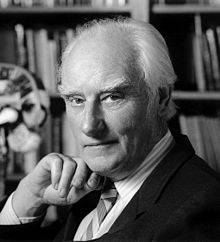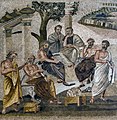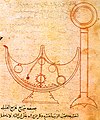Portal:History of science
The History of Science Portal
The history of science covers the development of science from ancient times to the present. It encompasses all three major branches of science: natural, social, and formal. Protoscience, early sciences, and natural philosophies such as alchemy and astrology during the Bronze Age, Iron Age, classical antiquity, and the Middle Ages declined during the early modern period after the establishment of formal disciplines of science in the Age of Enlightenment.
Science's earliest roots can be traced to Ancient Egypt and Mesopotamia around 3000 to 1200 BCE. These civilizations' contributions to mathematics, astronomy, and medicine influenced later Greek natural philosophy of classical antiquity, wherein formal attempts were made to provide explanations of events in the physical world based on natural causes. After the fall of the Western Roman Empire, knowledge of Greek conceptions of the world deteriorated in Latin-speaking Western Europe during the early centuries (400 to 1000 CE) of the Middle Ages, but continued to thrive in the Greek-speaking Byzantine Empire. Aided by translations of Greek texts, the Hellenistic worldview was preserved and absorbed into the Arabic-speaking Muslim world during the Islamic Golden Age. The recovery and assimilation of Greek works and Islamic inquiries into Western Europe from the 10th to 13th century revived the learning of natural philosophy in the West. Traditions of early science were also developed in ancient India and separately in ancient China, the Chinese model having influenced Vietnam, Korea and Japan before Western exploration. Among the Pre-Columbian peoples of Mesoamerica, the Zapotec civilization established their first known traditions of astronomy and mathematics for producing calendars, followed by other civilizations such as the Maya.
Natural philosophy was transformed during the Scientific Revolution in 16th- to 17th-century Europe, as new ideas and discoveries departed from previous Greek conceptions and traditions. The New Science that emerged was more mechanistic in its worldview, more integrated with mathematics, and more reliable and open as its knowledge was based on a newly defined scientific method. More "revolutions" in subsequent centuries soon followed. The chemical revolution of the 18th century, for instance, introduced new quantitative methods and measurements for chemistry. In the 19th century, new perspectives regarding the conservation of energy, age of Earth, and evolution came into focus. And in the 20th century, new discoveries in genetics and physics laid the foundations for new sub disciplines such as molecular biology and particle physics. Moreover, industrial and military concerns as well as the increasing complexity of new research endeavors ushered in the era of "big science," particularly after World War II. (Full article...)
Selected article -
Science in the ancient world encompasses the earliest history of science from the protoscience of prehistory and ancient history to late antiquity. In ancient times, culture and knowledge were passed through oral tradition. The development of writing further enabled the preservation of knowledge and culture, allowing information to spread accurately.
The earliest scientific traditions of the ancient world developed in the Ancient Near East, with Ancient Egypt and Babylonia in Mesopotamia. Later traditions of science during classical antiquity were advanced in ancient Persia, Greece, Rome, India, China, and Mesoamerica. Aside from alchemy and astrology that waned in importance during the Age of Enlightenment, civilizations of the ancient world laid the roots of modern sciences. (Full article...)
Selected image

A Philosopher Lecturing on the Orrery (sometimes called simply The Orrery) is a painting (oil on canvas, ca. 1766) by Joseph Wright of Derby depicting a public lecture about a model Solar System, with a lamp—in place of the Sun—illuminating the faces of the audience. Wright captures the spirit of the Enlightenment, with knowledge as a force of moral uplift for the audience of commoners under the tutelage of the natural philosopher. Consistent with the astronomical theme, the partially illuminated faces may represent the phases of the Moon, ranging from full (the children) to gibbous (the man standing on the left) to new (the figure seen from behind).
Did you know
...that Einstein's famous letter to FDR about the possibility of an atomic bomb was actually written by Leó Szilárd?
...that geology was transformed in the latter part of the 20th century after widespread acceptance of plate tectonics?
...that the idea of biological evolution dates to the ancient world?
Selected Biography -

Francis Harry Compton Crick OM FRS (8 June 1916 – 28 July 2004) was an English molecular biologist, biophysicist, and neuroscientist. He, James Watson, Rosalind Franklin, and Maurice Wilkins played crucial roles in deciphering the helical structure of the DNA molecule.
Crick and Watson's paper in Nature in 1953 laid the groundwork for understanding DNA structure and functions. Together with Maurice Wilkins, they were jointly awarded the 1962 Nobel Prize in Physiology or Medicine "for their discoveries concerning the molecular structure of nucleic acids and its significance for information transfer in living material". (Full article...)
Selected anniversaries
- 1686 – Death of Nicolas Steno, Danish geologist (b. 1638)
- 1694 – Death of Ismael Bullialdus, French astronomer (b. 1605)
- 1703 – The Great Storm of 1703, the greatest windstorm ever recorded in the southern part of Great Britain, reaches its peak intensity which it maintains through November 27. Winds gust up to 120 mph, and 9,000 people die
- 1703 – Birth of Jean-François Séguier, French astronomer and botanist (d. 1784)
- 1714 – Birth of Yoriyuki Arima, Japanese mathematician (d. 1783)
- 1814 – Birth of Julius Robert von Mayer, German physician and physicist (d. 1878)
- 1841 – Birth of Ernst Schröder, German mathematician (d. 1902)
- 1867 – Alfred Nobel patents dynamite
- 1884 – Death of Adolph Wilhelm Hermann Kolbe, German chemist (b. 1818)
- 1887 – Birth of Nikolai Vavilov, Russian geneticist (d. 1943)
- 1940 – Birth of Reinhard Furrer, American physicist and astronaut (d. 1995)
- 1972 – Death of Henri Coandă, Romanian aerodynamics pioneer (b. 1886)
Related portals
Topics
General images
Subcategories
Things you can do
Help out by participating in the History of Science Wikiproject (which also coordinates the histories of medicine, technology and philosophy of science) or join the discussion.
Associated Wikimedia
The following Wikimedia Foundation sister projects provide more on this subject:
-
Commons
Free media repository -
Wikibooks
Free textbooks and manuals -
Wikidata
Free knowledge base -
Wikinews
Free-content news -
Wikiquote
Collection of quotations -
Wikisource
Free-content library -
Wikiversity
Free learning tools -
Wiktionary
Dictionary and thesaurus








































































